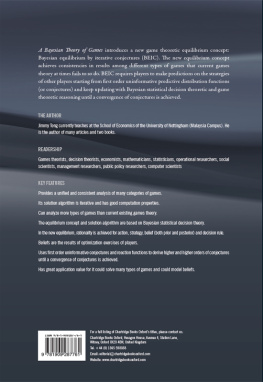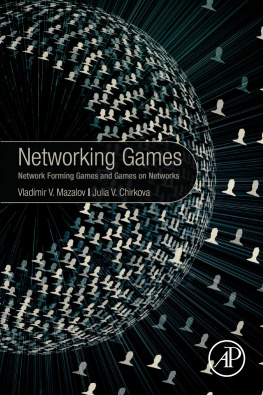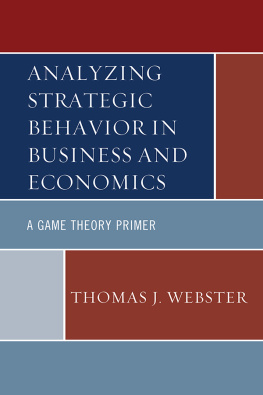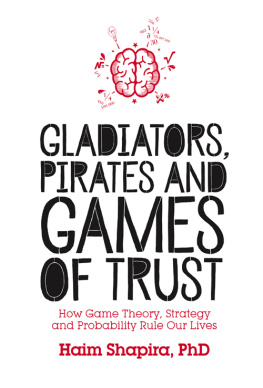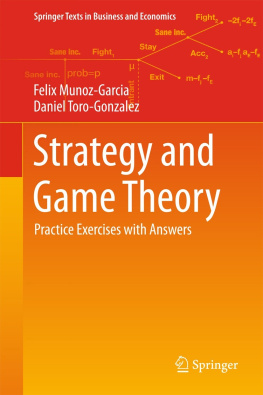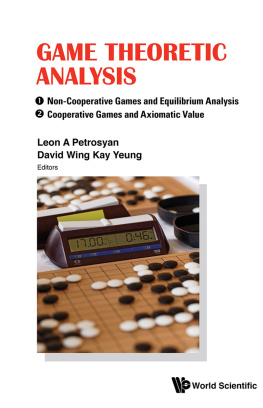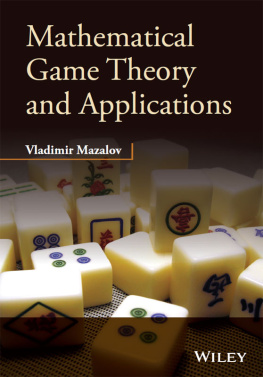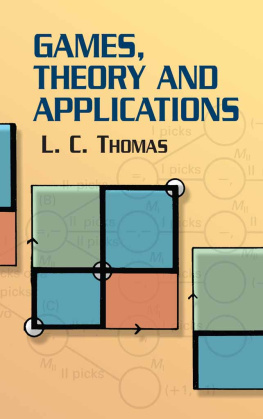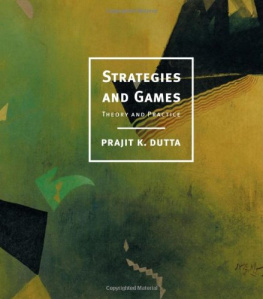A Bayesian Theory of Games
A Bayesian Theory of Games
Iterative conjectures and determination of equilibrium
J IMMY T ENG

Chartridge Books Oxford
Hexagon House
Avenue 4
Station Lane
Witney
Oxford OX28 4BN, UK
Tel: +44 (0) 1865 598888
Email:
Website: www.chartridgebooksoxford.com
Published in 2014 by Chartridge Books Oxford
ISBN print: 978-1-909287-76-1
ISBN digital (pdf): 978-1-909287-77-8
ISBN digital book (epub): 978-1-909287-78-5
ISBN digital book (mobi): 978-1-909287-79-2
J. Teng 2014
The right of J. Teng to be identified as author of this work has been asserted in accordance with sections 77 and 78 of the Copyright, Designs and Patents Act 1988.
British Library Cataloguing-in-Publication Data: a catalogue record for this book is available from the British Library.
All rights reserved. No part of this publication may be reproduced, stored in or introduced into a retrieval system, or transmitted, in any form, or by any means (electronic, mechanical, photocopying, recording or otherwise) without the prior written permission of the publishers. This publication may not be lent, resold, hired out or otherwise disposed of by way of trade in any form of binding or cover other than that in which it is published without the prior consent of the publishers. Any person who does any unauthorised act in relation to this publication may be liable to criminal prosecution and civil claims for damages. Permissions may be sought directly from the publishers, at the above address.
Chartridge Books Oxford is an imprint of Biohealthcare Publishing (Oxford) Ltd.
The use in this publication of trade names, trademarks service marks, and similar terms, even if they are not identified as such, is not to be taken as an expression of opinion as to whether or not they are subject to proprietary rights. The publishers are not associated with any product or vendor mentioned in this publication. The authors, editors, contributors and publishers have attempted to trace the copyright holders of all material reproduced in this publication and apologise to any copyright holders if permission to publish in this form has not been obtained. If any copyright material has not been acknowledged, please write and let us know so we may rectify in any future reprint. Any screenshots in this publication are the copyright of the website owner(s), unless indicated otherwise.
Limit of Liability/Disclaimer of Warranty
The publishers, author(s), editor(s) and contributor(s) make no representations or warranties with respect to the accuracy or completeness of the contents of this publication and specifically disclaim all warranties, including without limitation warranties of fitness for a particular purpose. No warranty may be created or extended by sales or promotional materials. The advice and strategies contained herein may not be suitable for every situation. This publication is sold with the understanding that the publishers are not rendering legal, accounting or other professional services. If professional assistance is required, the services of a competent professional person should be sought. No responsibility is assumed by the publishers, author(s), editor(s) or contributor(s) for any loss of profit or any other commercial damages, injury and/or damage to persons or property as a matter of products liability, negligence or otherwise, or from any use or operation of any methods, products, instructions or ideas contained in the material herein. The fact that an organisation or website is referred to in this publication as a citation and/or potential source of further information does not mean that the publishers nor the author(s), editor(s) and contributor(s) endorses the information the organisation or website may provide or recommendations it may make. Further, readers should be aware that internet websites listed in this work may have changed or disappeared between when this publication was written and when it is read.
Typeset by Domex, India
Printed in the UK and USA

Contents

Preface
This book introduces a new games theory equilibrium concept and solution algorithm that provide a unified treatment for broad categories of games that are presently solved using the different equilibrium concepts of Nash equilibrium, sub-game perfect equilibrium, Bayesian Nash equilibrium and perfect Bayesian equilibrium.
The new method achieves consistency in equilibrium results that current games theory at times fails to, such as those between Perfect Bayesian Equilibrium and backward induction (sub-game Perfect Equilibrium). The new equilibrium concept is Bayesian equilibrium by iterative conjectures (BEIC) and its associated algorithm is the Bayesian iterative conjecture algorithm. BEIC requires players to make predictions on the strategies of other players using the Bayesian iterative conjecture algorithm. The Bayesian iterative conjectures algorithm makes predictions starting from first order uninformative predictive distribution functions (or conjectures) and keeps updating with the Bayesian statistical decision theoretic and game theoretic reasoning until a convergence of conjectures is achieved. Information known by the players such as the reaction functions are thereby incorporated into the higher order conjectures and help to determine the convergent conjectures and the associated equilibrium.
In a BEIC, conjectures are consistent with the equilibrium or equilibriums they support and so rationality is achieved for actions, strategies and conjectures and (statistical) decision rule.
The BEIC approach is capable of analyzing a larger set of games than current games theory, including games with noisy inaccurate observations and games with multiple-sided incomplete information games. On the other hand, for the set of games analyzed by the current games theory, it generates smaller numbers of equilibriums and normally achieves uniqueness in equilibrium. It treats games with complete and perfect information as special cases of games with incomplete information and noisy observations, whereby the variance of the prior distribution function on type and the variance of the observation noise term tend to zero. Consequently, there is the issue of indeterminacy in statistical inference and decision-making in these games as the equilibrium solution depends on which variance tends to zero first. It therefore identifies equilibriums in these games that have so far eluded current treatments.

Acknowledgments
I thank D. Banks, J. Bono, P. Carolyn, M. Clyde, J. Duan, I. Horstmann, P.Y. Lai, M. Lavine, J. Mintz, R. Nau, M. Osborne, J. Roberts, D. Schoch, R. Winkler, R. Wolpert, F.Y. Chiou, and G. Xia for their comments.
I thank the students of my 2005, 2008 and 2009 games theory classes (at the Department and Graduate Institute of Political Science in the National Taiwan University in Taipei, Taiwan) for their enthusiasm in learning, and interesting questions raised in class.
I thank the participants of my three-day games theory workshop (at the Graduate Institute of Political Science in the National Sun Yat Sen University in Kaohsiung, Taiwan) for their questions.
Next page
